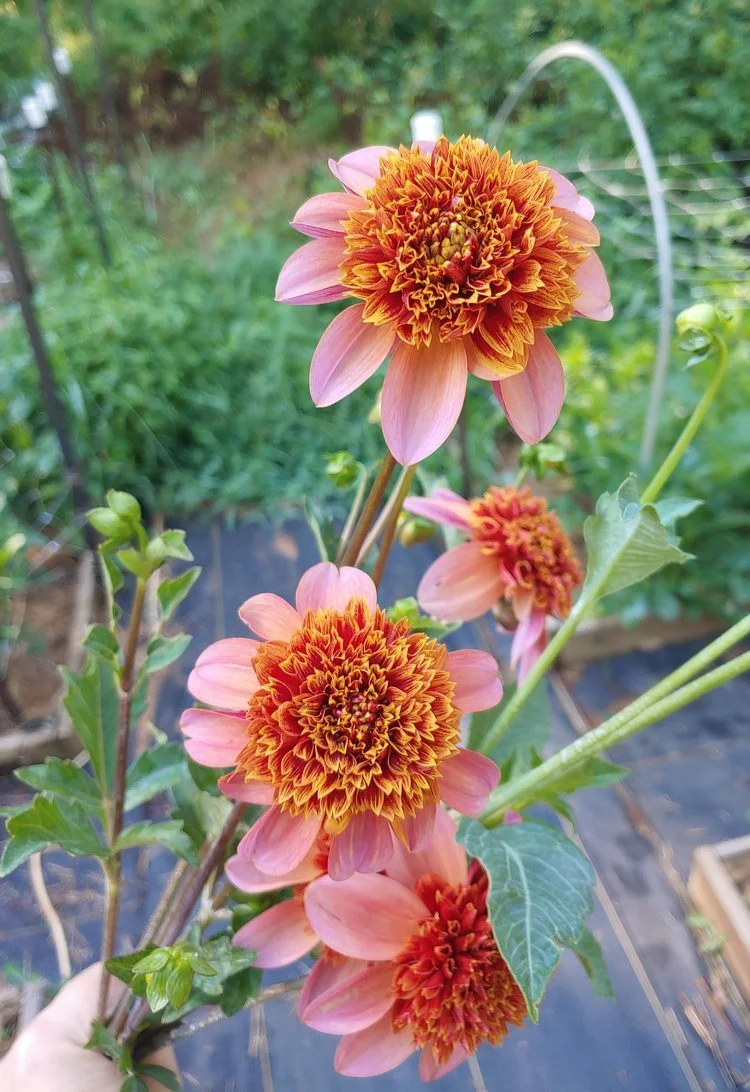
Clearview Peachy
Clearview Peachy- this variety turns every shade of peach throughout the season. You can have it all in one peach dahlia! ;)
Clearview Peachy- My favorite coloring is the above- I like the nude peachy. It goes with so many things and I get asked for a nude peach a lot. Definitely growing more of this one next year!
Dreamy Dahlias: Soft Cool Pastels
These are the cottage garden dahlias- the ones you mix in with all your roses and cosmos. These give you the English garden look here in a hot climate.
Marionberry Milkshake- Great name, great dahlia! This beauty is a steady bloomer and has a strong stout plant habit. It could almost stand on it’s own without support if you placed it amongst other strong plants in a perennial border. It’s fluffy and the pale silvery lavender color just makes me feel peaceful.
Skipley Moonglow- Creamy butter yellow- one of my favorite colors! It can have a tinge of pink in the center sometimes. Blooms a little later in the season- mid September but keeps going once it gets started. This one helps warm up this cool palette of silvery pastels.
Sweet Nathalie- Sometimes she’s lavender pink, sometimes silver cool pink. Great companion to 20th Ave Memory- like a bigger older sister. Beautiful soft pink, really adds the romance to your cottage garden.
Camano Zoe- Every romance needs a bit of whimsy- Enter Camano Zoe! Cute as a button. Small white pom dahlia with pinkish highlights. Gives lots of blooms and is tall enough to make a statement in your garden.
Sterling Silver- You can’t have a romantic cottage garden without some white. This dahlia is a beautiful soft white with a pillowy fluffy feel to it. Lots of layers that create a voluminous effect as it opens.
A Rose By Any Other Name: Bracken Rose
A Rose By Any Other Name- Funny thing is that Bracken Rose isn’t the true name of this dahlia. It came out a few years ago that this dahlia had been going by the wrong name in the US all these years. There are a few varieties of dahlias that have different names in Europe. So that’s why you see this one listed as Bracken Rose ( US version) often.
Bracken Rose ( US Version)- Whatever you want to call her, she’s beautiful. Blooms a bit later than some but it’s actually nice because the few times I’ve gotten an early bloom, I’ve noticed she gets a hard green center. So I’ll take a later fall bloom- she works well with other later fall blooms anyways!
Summer Dahlias: Juicy Sweet Berry Tones
These dahlias scream summer to me because they remind me of all the delicious berries available roaming the countryside! Ok- it’s more like shopping my local farmers market but a girl can dream can’t she?
Jabberbox- Oh she’s so good. The perfect magenta raspberry pink! I would really like to know the story behind her name though. You’d think she’d be something with raspberry or strawberry kiss or something like that! Strong stems, doesn’t mind the heat, steady bloomer.
Sweet Fabienne- she’s the perfect pink and sometimes gets laciniate petals which I love! Prolific and steady bloomer- has the same growth habit of Linda’s Baby.
Lynn Slight- Deep dark berry tones. This one is a good alternate if you don’t like Diva- although I’m not sure if anyone doesn’t like Diva. But she’s similar, a little smaller though. Also blooms a little earlier than Diva- that can be a nice quality.
Doodlebug- Gotta love the name. I like dahlias with fun names! This dahlia can be pinker red in a cooler year or red with some golden highlights if it’s hotter. Either way, it’s a perfect summer berry color!
Like Totally…Totally Tangerine!
Like Totally— go ahead and say it in your best valley girl voice! Totally Tangerine is one dahlia that I’ve never found anyone who didn’t like it!
She doesn’t have the greatest vase life but well worth growing for your own enjoyment. She’s quick to bloom and will give you lots of blooms if you deadhead- multiple buds per stem. Then once all those buds have opened, cut it back by half and it will give you another flush. Great garden dahlia!







































